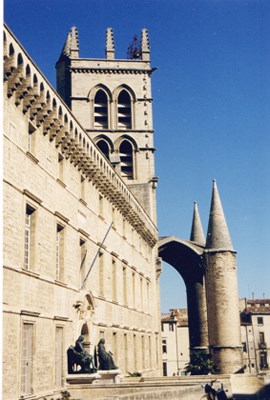Dodging skateboards and street artists, we step across the egg-shaped, yellow marble outline of Montpellier's Place de la Comédie and step back in time.
Sipping café au lait we survey the elegant architecture of theatres and hotels around the large oval area nicknamed "the egg."I t's easy to imagine the 18th century elite who came here to stroll, chat, flirt, people watch and simply hang out beneath the town's statue of the Three Graces - an activity known for centuries as faire l'oeuf, "doing the egg." Today, an eclectic mix of university students, young families, elderly couples and tourists still "do the egg" here in the sunny capital of France's Bas-Languedoc.
We pull ourselves away from the egg to explore cobbled alleyways and tree flanked promenades, meandering past historic monuments and Gothic vaulted cellars. We suffer Parisian déjà -vu because so much of the architecture and statuary here mimic the capital: the elaborate opera house, a miniature replica of the one in Paris; the classical Chateau d'Eau (water tower); the Palais de Justice, and streets like Rue Foch, a mirror image of the one in the capital.
Our guide's weighty antique key gives us access to the Arc de Triomphe, yet another copy of a Parisian original. From its top, we overlook the St. Clement aqueduct and the Promenade du Peyrou before moving on to the old town, or "Ãcusson," so named because its layout resembles the shape of a medieval shield. This ancient rabbit warren of crooked passageways is crammed with expensive boutiques, tiny cafés and homely apartments with balconies gaudy with scarlet geraniums. We amble to the unique Romantic-Gothic Cathédrale Saint Pierre - unique because it is shared with the university's Faculty of Medicine and home (on the first floor) to a bizarre Museum of Anatomy. The medical university was huge even in the 13th century: the cathedral is a mere upstart, dating from the 14th.
Food is, of course, a passion here and Ãcusson is a perfect place to have lunch. We relax in the dappled sunshine, enjoying a local specialty: galettes, hearty crêpes stuffed with exotic fillings like "Galette Francois 1er," a whole wheat crêpe bursting with shrimp, mushrooms and béchamel sauce. We sit, somnolent in the sun, sipping the local wine and entertained by strolling musicians. For dinner tonight, there's the Bistro Du Théatre, a lively, noisy place offering a hearty seafood soup, with classic aioli and grated cheese. Tomorrow, we'll treat ourselves to the splendid L'Estrale waterfront restaurant in nearby Palavas Les Flots, a harbour town garlanded with lights where we can sit beneath the stars, warmed by a light summer breeze.
From our base in Montpellier, we tear ourselves away from food long enough to drive out along the curve of the Mediterranean coast towards Aigues Mortes, the wind fluffing the water into playful whitecaps. Passing the resort town of La Grande Motte we traverse a flat, sandy landscape of inland lagoons dotted with flamingos and oyster cultivation. It's a land full of history, with places that have been home to great cruelties over the centuries. Aigues Mortes, for example, is a walled town, still protected by massive ramparts and fortified gates, which once held France's only women's prison and which saw the mass emigration of persecuted Huguenots.
We drive to the hugely impressive Roman aqueduct at nearby Pont Du Gard. Begun in 20 BC, it's stunning in its sheer size - nearly 60 metres high - but all the more amazing because of the engineering feat it represents. Designed to carry water across the small Gardon river valley, it was part of a nearly 50-kilometre aqueduct that had a gradient of just 0.034%, descending only 17 metres vertically in its entire length and delivering 20,000 cubic meters (44 million gallons) of water daily. Small wonder it is a UNESCO World Heritage Site today.
Nearby slumbers the small town of Uzès, dominated by the cathedral and its campanile tower. This Tour Fenestrelle is supposedly the only one of its kind in France, resembling a Leaning Tower of Pisa without the slant. We wander deep into the old town, shuttered and ghost-town empty in the intense midday sun. We choose a homely café full of local families and lunch on "down home" cassoulet - chunks of duck, thick country sausage and white beans that have never known the inside of a can.
Montpellier is growing fast, expanding across the 13 kilometres separating it from the Mediterranean, and filling up with shopping malls, apartment blocks, a rugby stadium and other modern necessities. With 21 per cent of its population students, it's the perfect place to host the annual International Festival of Extreme Sports each May. But for those with gentler tastes, it lies amidst fertile, rolling farmland, home to hot mistral winds but also home to orchards of peaches and bowers of grapes. In spring, the region wears pink and white skirts of apple and cherry blossom. In sun-drenched summer, it's embroidered with the rich purple of lavender fields.
Montpellier was named as the New York Times' French Place to Visit in 2012 but it was "discovered" centuries before. Nostradamus, Rabelais and Petrarch all chose to study and live here in this ancient university city, delightfully nick-named the Oxford of France. We too came here for its beauty, history and gastronomy. Just as visitors have done over the centuries, we came to "do the egg" and left more than satisfied.



